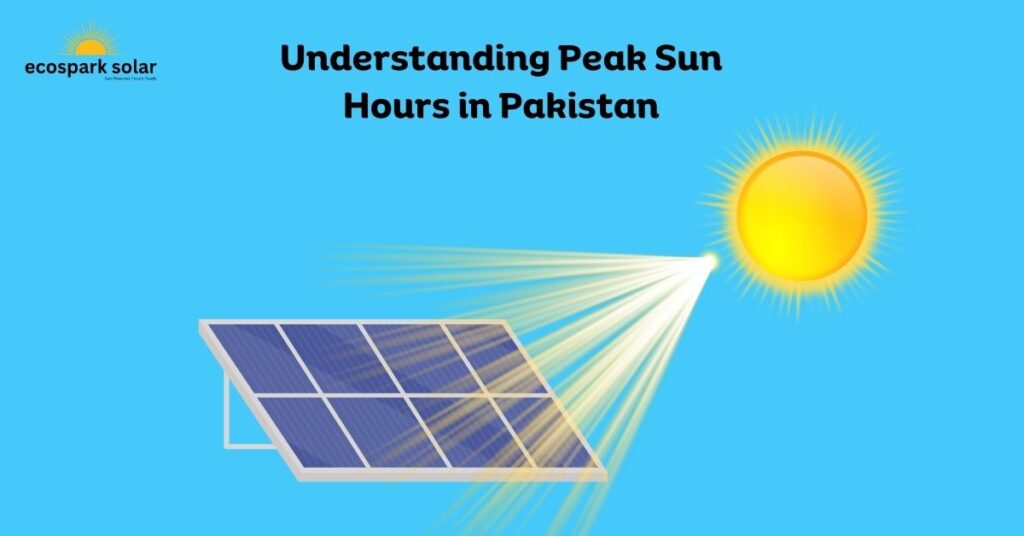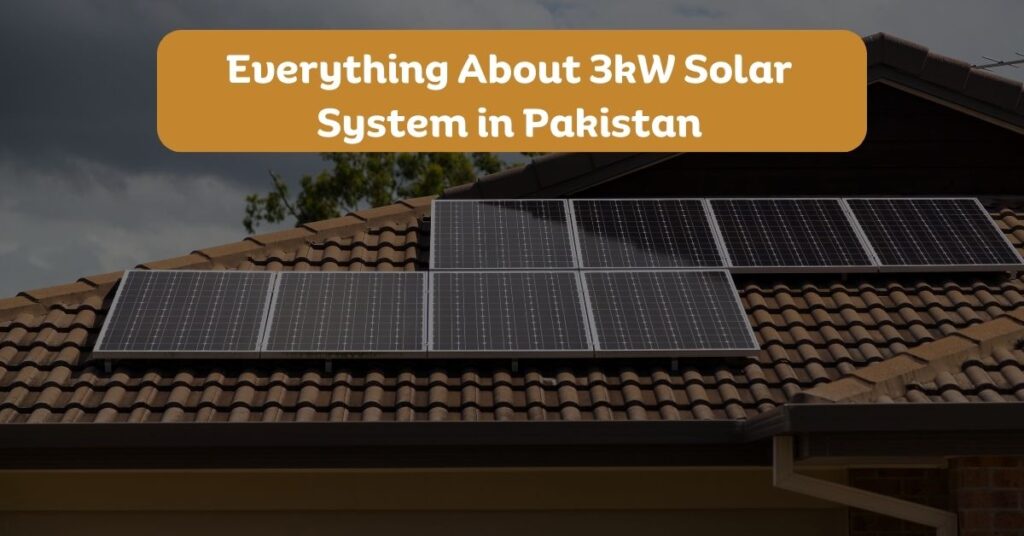Welcome to a comprehensive exploration of peak sun hours in Pakistan, where abundant solar energy can be harnessed to power a greener future. But when going solar, you may have come across the term “peak sun hours.” Experts recommend that it is important to keep this in mind when installing a solar system. Why it is important? Because assessing peak sun hours help us accurately determine the size of a solar system we need.
But what are peak sun hours?
That is the subject of this article. In this article, we will dive deep into the intricacies of solar irradiation, irradiance, and various metrics associated with solar energy, shedding light on their significance for solar power generation in different regions of Pakistan.
Specifically, we will discuss the following:
- What is solar irradiation?
- What is solar irradiance?
- Types of solar irradiation, such as Global Horizontal Irradiation (GHI), Direct Normal Irradiation (DNI), and Diffuse Radiation.
- What are peak sun hours, and what metrics help calculate it?
- Average peak sun hours of Pakistan (Islamabad, Punjab, KPK, Baluchistan, and Sindh).
- How to make the most of your peak sun hours in Pakistan?
And more.
To begin with, let’s explore some basics first. But if you want a quick answer, then here it is: the number of peak sun hours in Pakistan ranges from 4 to 6 hours per day. I would recommend going through the article to help you make an informed decision – I have added graphs of the systems in real-time which would help you understand the subject in more detail.
Understanding Solar Radiation Metrics
Solar radiation metrics, also called solar resources, help us quantify the energy we receive from the sun. It can be measured in different ways. We will talk about each one of them below:
Solar Irradiation
Solar irradiation refers to the total amount of solar radiation energy received on a specific surface area over a given time period. It is commonly measured in watt-hours per square meter (Wh/m²) or kilowatt-hours per square meter (kWh/m²). Solar irradiation represents the cumulative energy received.
Solar Irradiance
Solar irradiance, on the other hand, measures the instantaneous power per unit area of solar radiation received on a surface. It is typically measured in watts per square meter (W/m²) and represents the intensity of solar radiation at a specific moment.
Differentiating Global Horizontal Irradiation (GHI), Direct Normal Irradiation (DNI), and Diffuse Radiation
Solar irradiation can be further categorized into different components:
Direct Normal Irradiation (DNI)
DNI refers to the solar radiation received from the direction of the sun when the sun is shining directly overhead without any obstructions. It represents the direct sunlight that reaches a surface perpendicularly. This metric is useful to us when calculating peak sun hours—more on this in the sections below.
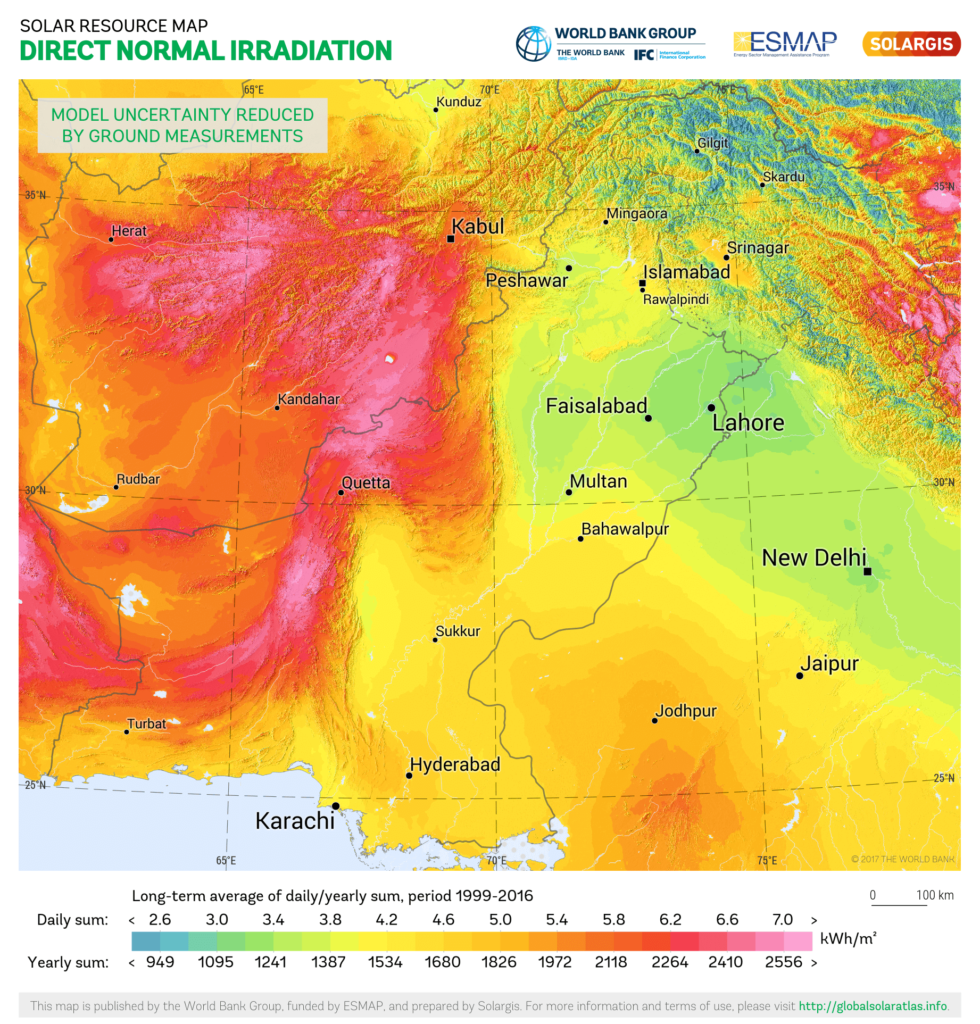
Diffuse Radiation
Diffuse radiation refers to the sunlight that is scattered by the atmosphere, resulting in a less concentrated and more scattered form of solar radiation. It occurs when sunlight interacts with air molecules, aerosols, and clouds.
Global Horizontal Irradiation (GHI)
GHI represents the total solar radiation received on a horizontal surface, including both direct sunlight (DNI) and diffuse radiation. It is the sum of direct and diffuse solar irradiance received on a horizontal plane.
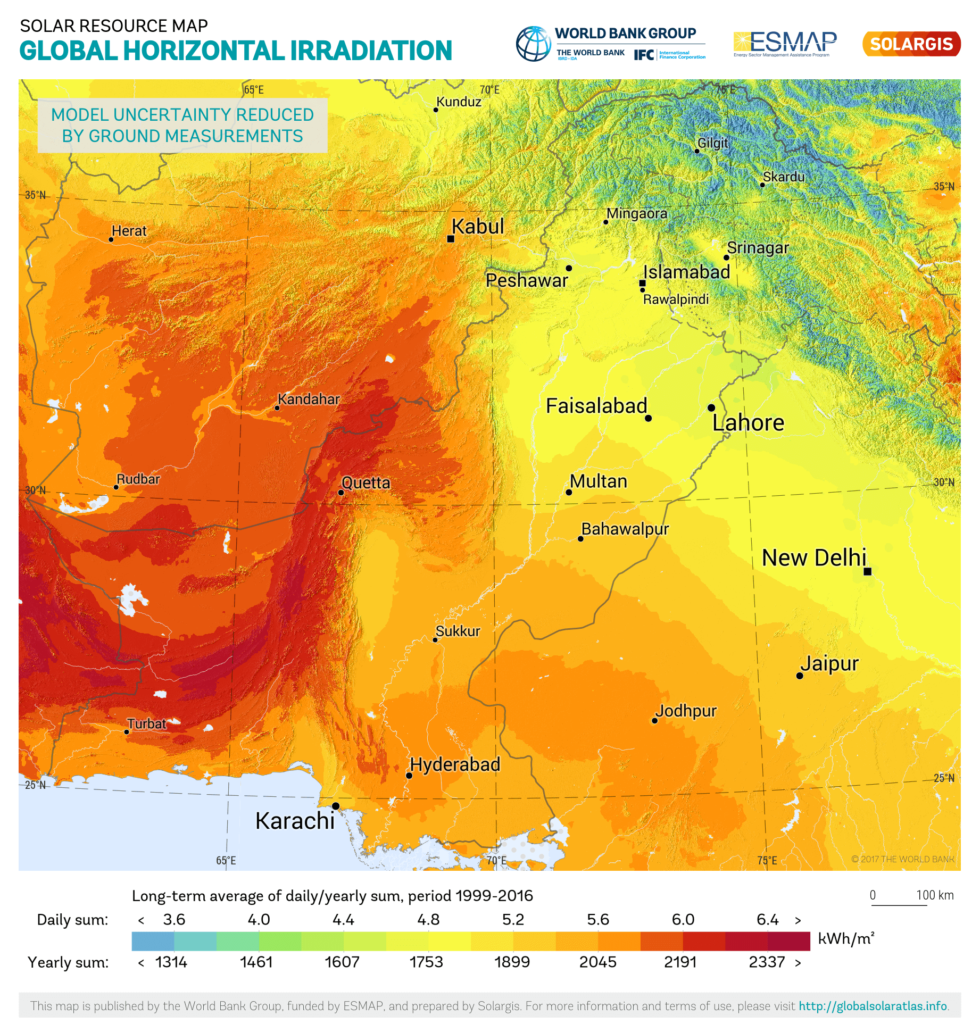
Focusing on Direct Normal Irradiation (DNI) for Peak Sun Hours
Peak sun hours are the specific hours during the day when the sunlight is strongest and most intense. As discussed above, it is measured in watt-hours per square meter (wh/ m²). In Pakistan, the sun shines above the whole day, from 6:00 am in the morning (in the summers) to 6:00 pm in the evening. But all of this sunshine is not enough to generate solar power, though it still can produce power.
To understand this better, let’s imagine we have a 1-kilowatt (1kW) solar panel. Think of it as a small energy-harvesting machine that converts sunlight into electricity.
Now, the power or energy that the sun provides to this solar panel is measured in watts per square meter (W/m²). To consider it as a good amount of sunlight, we often say that we need at least 1,000 watts per square meter (1,000 W/m²) of solar irradiance. It’s like having enough “energy juice” to power our 1kW solar panel effectively. Solar panels work at its maximum potential during peak hours, as tested in the laboratory. Our 1kW solar panel would give us 1kWh power during one peak sun hour.
Peak sun hours are the hours when the solar irradiance, or the energy juice from the sun, is equal to or greater than 1,000 W/m². During these peak sun hours, our 1kW solar panel can produce its full power potential and generate electricity efficiently.

If you do not understand this curve, skip it. In the following sections, I have added the production curve of a system we installed in Islamabad. That would give you a better idea.
An Example Would Illustrate This Better
If we have around 5 peak sun hours in a day, it means that during these 5 hours, our 10kW solar panel will be receiving enough solar energy to produce its maximum power output. This can result in generating around 50 kilowatt-hours (units) of electricity during those peak sun hours. This is why, when calculating your solar energy needs, we take into account the peak sun hours falling on your roof.
It’s important to note that solar panels can still produce electricity during non-peak hours, such as mornings, evenings, or cloudy days, but their power output might be lower because the sunlight is not as strong or intense. For example, maybe at 8:00 am, your 10kW solar panels would produce around 30 units. But as the day progresses, the number of units would get high. See the actual curve of a 5.8kW solar system we installed in Islamabad in the following section.
Understanding peak sun hours helps us determine the best time to harness the maximum potential of solar energy. Remember, the more peak sun hours we have, the more sunlight we receive and the more electricity we can produce from our solar panels. So, when considering solar energy, it’s important to keep an eye on those peak sun hours to make the most of the sun’s power!
A solar system for everyone.
We’re customer-centric; we will find you a solution within your budget. Whatever your project size, you can always save with Ecospark Solar.
Average Peak Sun Hours in Pakistan
The average peak sun hours vary across different regions in Pakistan. On average, it ranges from 4 to 6 hours a day. Across most of Pakistan, the number of peak sun hours is 5 per day.
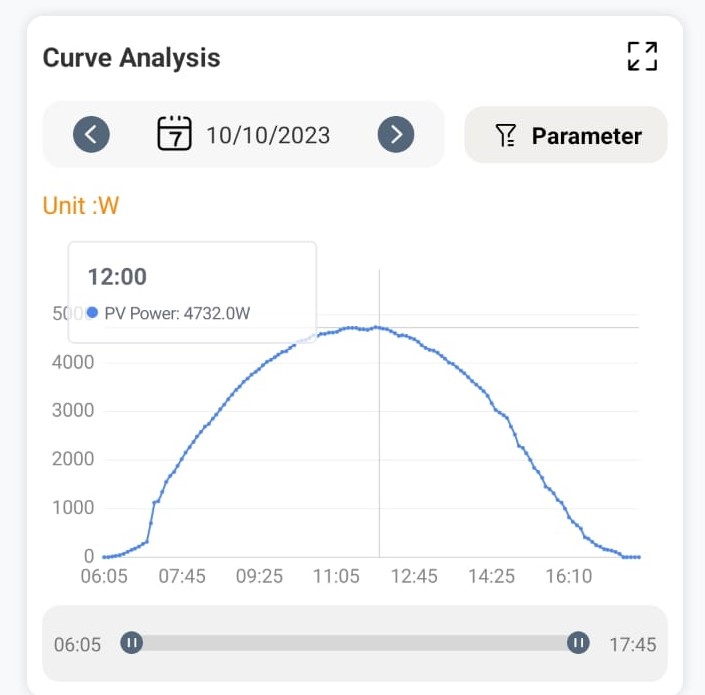
If you look at the production of this system, the generation of power starts around 6:00am, but the power is low. This is the month of October. As the day goes by, the production gets high and at the peak, around 12:00pm, the production is highest. From 10:00am to 4:00pm, the production is better – that’s around 6 peak sun hours.
Interesting Read: How Much Power Does a Solar Panel Produce in Pakistan?
Let’s explore the average values for some notable areas.
Peak Sun Hours in Islamabad
The capital city of Pakistan experiences an average of 5 to 6 peak sun hours per day throughout the year. These hours offer substantial solar energy potential for power generation. It means that a 5kW solar system can generate 25 to 30 units a day—and 750 to 900 units a month.
Thanks to net mering in Islamabad, with this much power generated a day, you can bring your electricity bill virtually to zero.
Peak Sun Hours in Punjab
The fertile plains of Punjab receive approximately 6 to 7 peak sun hours per day. In winter, the number of sun hours can decrease. In Punjab, the southern part receives more sun yearly than its northern counterpart. Still, this region’s ample sunlight makes it a favorable location for solar energy utilization.
Peak Sun Hours in Khyber Pakhtunkhwa (KPK)
The scenic province of Khyber Pakhtunkhwa enjoys an average of 5 to 6 peak sun hours daily. Some areas, such as Peshawar, Mardan, Swabi, and Nowshera, receive more peak sun hours. These hours provide an opportunity for significant solar energy harnessing.
Peak Sun Hours in Balochistan
The vast expanse of Balochistan boasts an impressive average of 7 to 8 peak sun hours per day, the highest in Pakistan. This region’s extended sunlight duration presents immense potential for solar power generation—it would be a tragedy not to make use of it.
Peak Sun Hours in Sindh
In Sindh, the average peak sun hours range from 6 to 7 hours per day. This region benefits from ample sunlight throughout the year, making it highly suitable for solar energy generation.
With an average of 6 to 7 peak sun hours in Sindh, solar power systems installed in this region can harness a significant amount of solar energy, enabling the generation of clean and sustainable electricity.
You May Like to Read: A Guide to Solar Financing Options in Pakistan
How to Make the Most of Your Solar System?
While peak sun hours are important, it is not just one way to optimize solar energy production on your rooftop. To optimize solar energy generation, you will have to consider the following factors as well.
Orientation Angle in Pakistan
Align your solar panels to face south in Pakistan to capture maximum sunlight. The optimal tilt angle for solar panels is generally equal to the latitude of the location. In Pakistan, it ranges from 22 to 32 degrees.
Azimuth Angle in Pakistan
Adjust the tilt angle of your panels based on your latitude to ensure optimal sunlight absorption throughout the day. Installing it directly against the sun will receive sunlight only in the first half of the day. You will have to install an azimuth that will continue generating power during the whole day.
In Pakistan, the azimuth angle is 180 degrees. But there may be exceptions—for example, schools are open only for the first half of the day. You can target the first half to generate as much power as possible.
Read more about the tilt and azimuth angle here.
Shading on Your Rooftop
Minimize shading caused by nearby structures, trees, or other obstructions that can hinder solar exposure and reduce energy generation. The more direct the sunlight falls on your solar panel, the more power it will generate.
How Many Peak Sun Hours Needed to Go Solar in Pakistan?
The more, the better. But usually, areas with 4 peak sun hours are considered suitable for installing a solar power system. While high peak sun hours are advantageous for solar energy generation, regions with relatively lower peak sun hours can still benefit from solar power. Advancements in technology and improved panel efficiency enable solar systems to produce significant electricity even in areas with less intense sunlight.
Similarly, peak sun hours is just one metric. If electricity is expensive in your area—or you consume more, and the tariff slab policy makes it expensive—you can still consider going solar.
Can solar panels operate during cloudy days in Pakistan?
While solar panels experience reduced energy production on cloudy days, they can still generate electricity. Panels are designed to capture diffuse radiation and convert it into usable energy. See the following graph. This is the production of a 6kW solar system installed in Islamabad. In September, there were rains and clouds in Islamabad. You would see decreased performance on cloudy days (for instance, see the production on 5th September). But the power is still generated.

Peak Sun Hours in Pakistan: Concluding Thoughts
With Pakistan’s favorable solar resource potential, understanding peak sun hours and solar radiation metrics is crucial for maximizing solar energy generation. On average, Pakistan experiences around 4 to 8 peak hours a day. By leveraging direct sunlight, optimizing system design, and considering regional variations, individuals and communities can unlock the power of the sun, contribute to a sustainable energy future, and embrace the benefits of solar power across the country.
